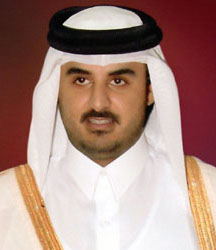State of Qatar

H.H Sheikh Tamim bin Hamad Al Thani His Highness the Emir of Qatar |
Background
Ruled by the Al Thani family since the mid-1800s, Qatar transformed itself from a the British protectorate noted mainly for pearling into an independent state with significant oil and natural gas revenues. During the late 1980s and early 1990s, the Qatari economy was crippled by a continuous siphoning off of petroleum revenues by the Amir, who had ruled the country since 1972. In 2001, Qatar resolved its longstanding border disputes with both Bahrain and Saudi Arabia. As of 2007, oil and natural gas revenues had enabled Qatar to attain the second-highest per capita income in the world.
Qatar has the world's largest per capita production and proven reserves of both oil and natural gas. In 2010, Qatar had the world's highest GDP per capita, while the economy grew by 19.40%, the fastest in the world. The main drivers for this rapid growth are attributed to ongoing increases in production and exports of liquefied natural gas, oil, petrochemicals and related industries. Qatar has the highest human development in the Arab World after the United Arab Emirates. In 2009, Qatar was the United States’ fifth largest export market in the Middle East, trailing behind the U.A.E., Israel, Saudi Arabia and Egypt. With a small citizen population of less than 300,000 people, Qatar relies heavily on foreign citizens, both for its protection and generating labor demand. Qatar has attracted an estimated $100 billion in investment, with approximately $60–70 billion coming from the U.S in the energy sector. It is estimated that Qatar will invest over $120 billion in the energy sector in the next ten years.
Population
Besides ethnic Arabs, much of the population is made up of expatriates taking up employment in various sectors of the Qatari economy. Arabic serves as the official language. However, English as well as many other languages like Hindi, Tamil, Kannada, Pashto, Malayalam, Punjabi, Urdu, Sindhi, Balochi, Telugu, Bengali, Tagalog, Somali. Expatriates form the majority of Qatar’s residents - nearly three quarters of the population. The petrochemical industry has attracted people from all around the world. Most of the expatriates come from South Asia (mainly India and to a lesser extent, Pakistan), and from non-oil-rich Arab states. Because a large percentage of the expatriates are male, Qatar has a heavily skewed sex ratio, with 3.46 males per female. In April 2001, the country had a growing population of approximately 907,229 people, of whom approximately 350,000 were believed to be citizens. The majority of the estimated 550,000 non-citizens are individuals from South and South East Asian and Arab countries working on temporary employment contracts in most cases without their accompanying family members. Most foreign workers and their families live near the major employment centers of Doha, Al Khor, Mesaieed, and Dukhan.

